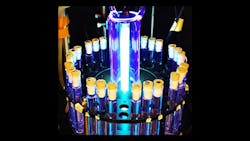Chemical engineering and environmental scientists recently published new methods to break up per- and polyfluoroalkyl substances (PFAS) into smaller compounds that are essentially harmless, according to a press release from the University of California Riverside (UCR) by David Danelski.
The patent-pending process infuses contaminated water with hydrogen, then blasts the water with high-energy, short-wavelength ultraviolet light. The hydrogen polarizes water molecules to make them more reactive, while the light catalyzes chemical reactions that destroy the pollutants.
This one-two punch breaks the strong fluorine-to-carbon chemicals bonds that make these pollutants so persistent and accumulative in the environment. In fact, the molecular destruction of PFAS increased from 10 percent to nearly 100 percent when compared to other ultraviolet water-treatment methods, while no other undesirable by-products or impurities are generated, the scientists reported in a paper recently published in the Journal of Hazardous Materials Letters.
“After the interaction, hydrogen will become water. The advantage of this technology is that it is very sustainable,” says Haizhou Liu, an associate professor in UCR’s Department of Chemical and Environmental Engineering and author of the paper.
Liu’s laboratory developed the technology with help from a $400,000 grant from the National Science Foundation.



